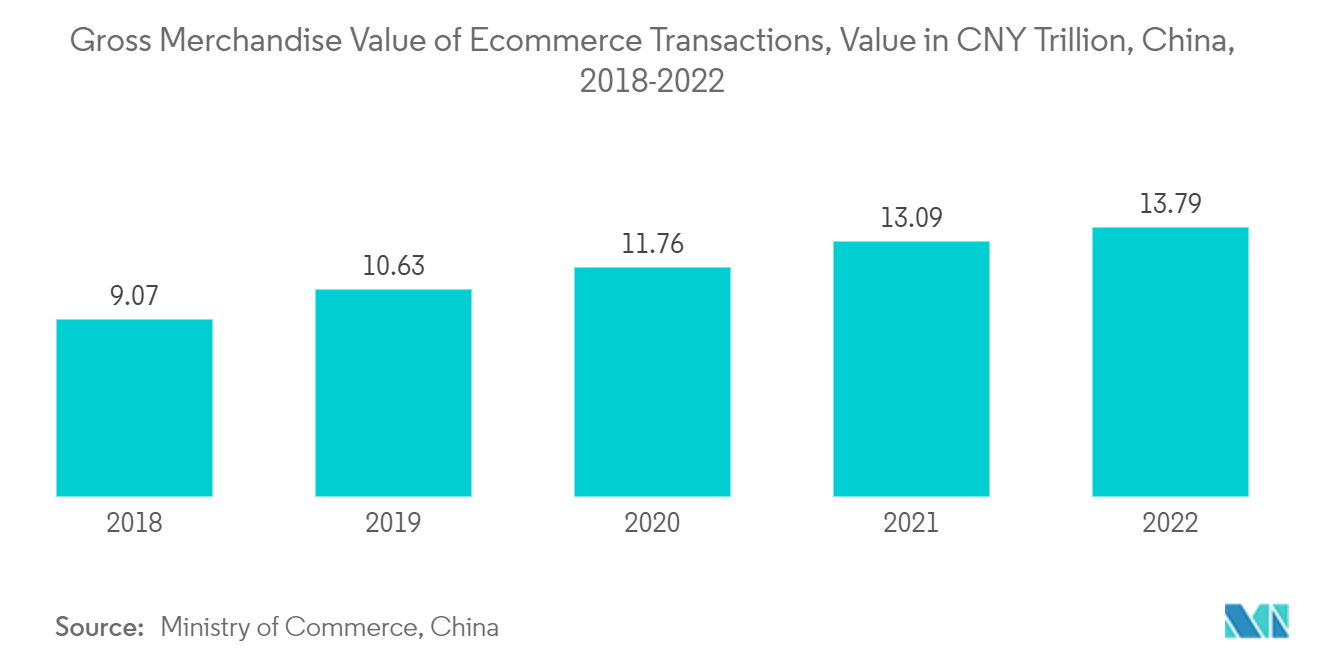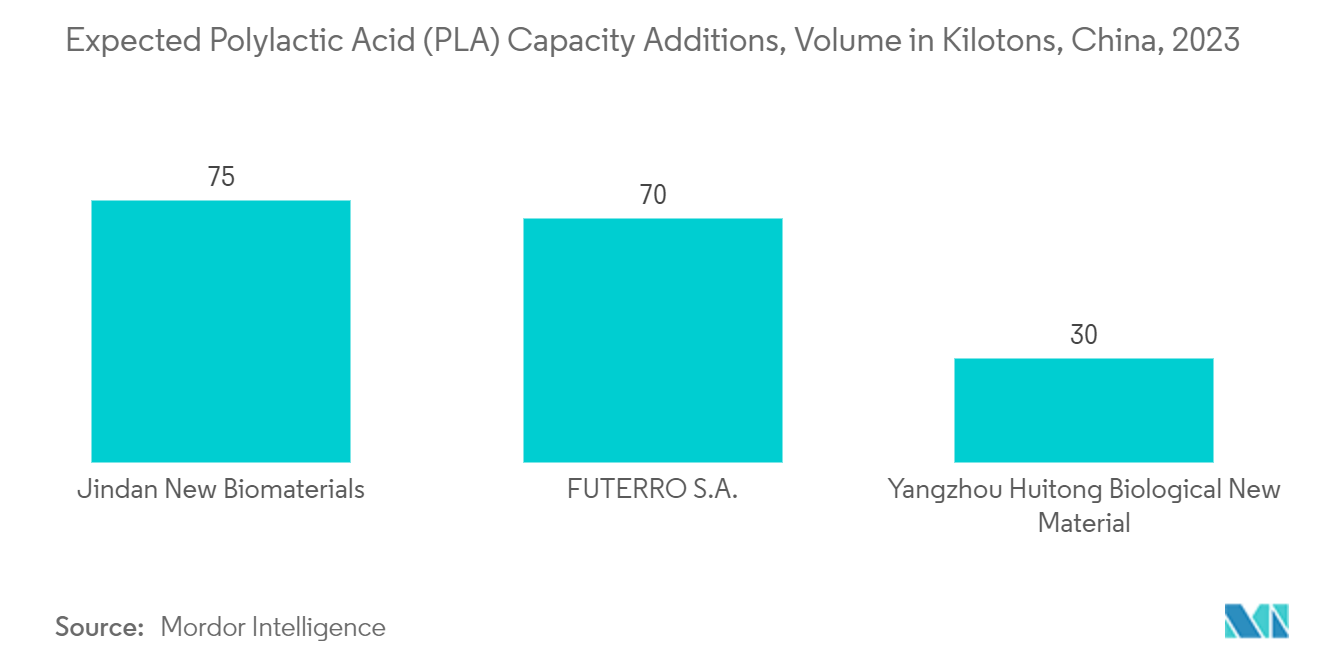Market Trends of China Bioplastics Industry
Flexible Packaging Industry to Dominate the Market
- Bioplastics are used in flexible packaging, as they are not harmful to nature, and few are easily degradable as well.
- They are used in packaging films for food items, medicines, beverage bottles, packaging films, and packaging of non-food products, such as napkins and tissues, toilet paper, nappies, sanitary towels, cardboard, and coat paper for food wrapping paper, and coated cardboard to make cups and plates. Moreover, they are used in flexible and loose-fill packaging.
- The consumption of bioplastics is increasing in making plastic bags, as they are nature-friendly, and for organic waste collection bags, which are majorly used in hospitals, hotels and restaurants, commercial and retail outlets, and houses.
- The Chinese company China BBCA Group has plans to increase its production capacity for polylactic acid (PLA) from 50 kilotons as of August 2020 to 700 kilotons by the end of 2023. The company's planned production capacity in 2023 would likely be nearly double the actual anticipated global demand volume for that year, which is estimated to be 360 kilotons.
- As for e-commerce, China has the highest online sales share in the world. Moreover, it also has the largest e-commerce market in the world, estimated to be around USD 2.9 trillion in 2022.
- As of 2022, Alibaba was China's leading e-commerce company, with a market capital of approximately CNY 1.5 trillion (USD 208.6 billion). There were as many as seven e-commerce companies among China's 500 leading private companies.
- According to the data from China's Ministry of Commerce, overall domestic e-commerce sales showed a steady increase, reaching CNY 13.79 trillion (USD 1.91 trillion), up 4% year-on-year in 2022. Online sales in rural areas reached CNY 2.17 trillion (USD 300.92 billion), up 4.9% year-on-year.
- Online sales in Northeast and Central China saw the highest increase in 2022, with annualized growth rates of 13.2% and 8.7%, respectively. Online sales volumes in East China in 2022 grew by 3.8% year-on-year, while West China recorded 3% year-on-year growth.
- With the growing e-commerce market and people preferring online shopping for items starting from FMCG products, medicines, electronics, food, and others, the demand for flexible packaging in e-commerce is expected to offer several growth opportunities in the coming years.

Polylactic Acid (PLA) to Dominate the Bio-based Biodegradables Segment
- Polylactic acid (PLA) is a bio-sourced and industrially compostable plastic/polymer material with a low carbon footprint. PLA's properties include transparency, rigidity, and the ability to act as a barrier to odors and grease. These attributes offer immense commercial potential.
- PLA has already been used in the medical industry for years to make suture threads and orthopedic rods. Currently, it meets the need in the growing markets, such as food packaging. The increasing intervention of the Food and Drug Administration (FDA) and related organizations in terms of food safety is largely promoting the usage of biodegradable food-grade plastics for beverage and snack consumption.
- PLA is gradually becoming a preferred material for more demanding applications in the textile, electronics, and automobile industries, as well as for new applications like hydraulic fracturing. PLA is currently one of the most widely used biodegradable materials. It is used in the manufacturing of fibers, coatings, films, and sheets, among others.
- The excellent biocompatibility, biodegradability, better encapsulation, and lower toxicity of PLA, PLA composites, and PLA copolymers have led to their adoption and usage in numerous applications in the bio-medical, injury management, and drug delivery systems. The major applications of bio-PLA in the medical sector include stitching, tissue re-engineering, orthopedics, antimicrobial agents, fractural facial repairs, biomaterials, and drug carriers.
- Bio-PLA is also being used in 3D printing, where aesthetics is of primary importance. Due to its lower printing temperature, it is easier to print parts with fine details. This ease of usage has enabled widespread applications of bio-PLA among schools and libraries for 3D printing. Moreover, it is the most preferred material among others, which is eco-friendly.
- Bio-PLA films and sheets are used to wrap organic food and premium and branded products. These films and sheets also provide an excellent surface for printing and are found to be ideal for applications of signage and folded cartons.
- PLA is a versatile material and is an excellent replacement for PS (polystyrene), PP (polypropylene), and ABS (acrylonitrile butadiene styrene) in more demanding applications.
- FUTERRO is amongst the major bio PLA producers in China and operates an integrated PLA production unit with a capacity of 30 kilotons per year, with plans to expand it to 100 kilotons per year.
- Moreover, amongst the recent developments, Sulzer has partnered with Jindan New Biomaterials and Yangzhou Huitong Biological New Material as key technology providers and equipment suppliers for their respective Bio PLA production units.
- With major production capacity additions, the Bio PLA market is expected to record significant growth in China.


